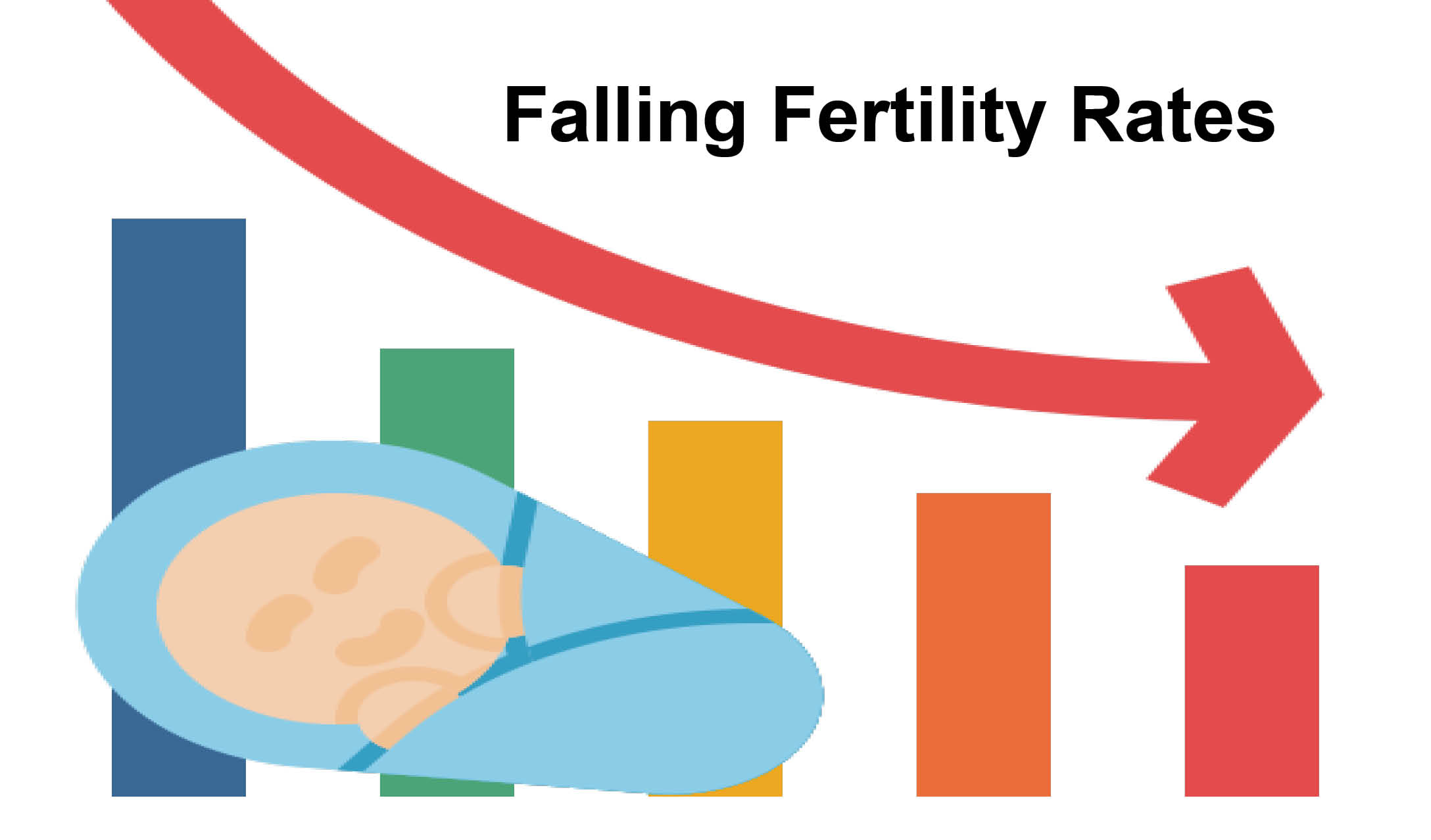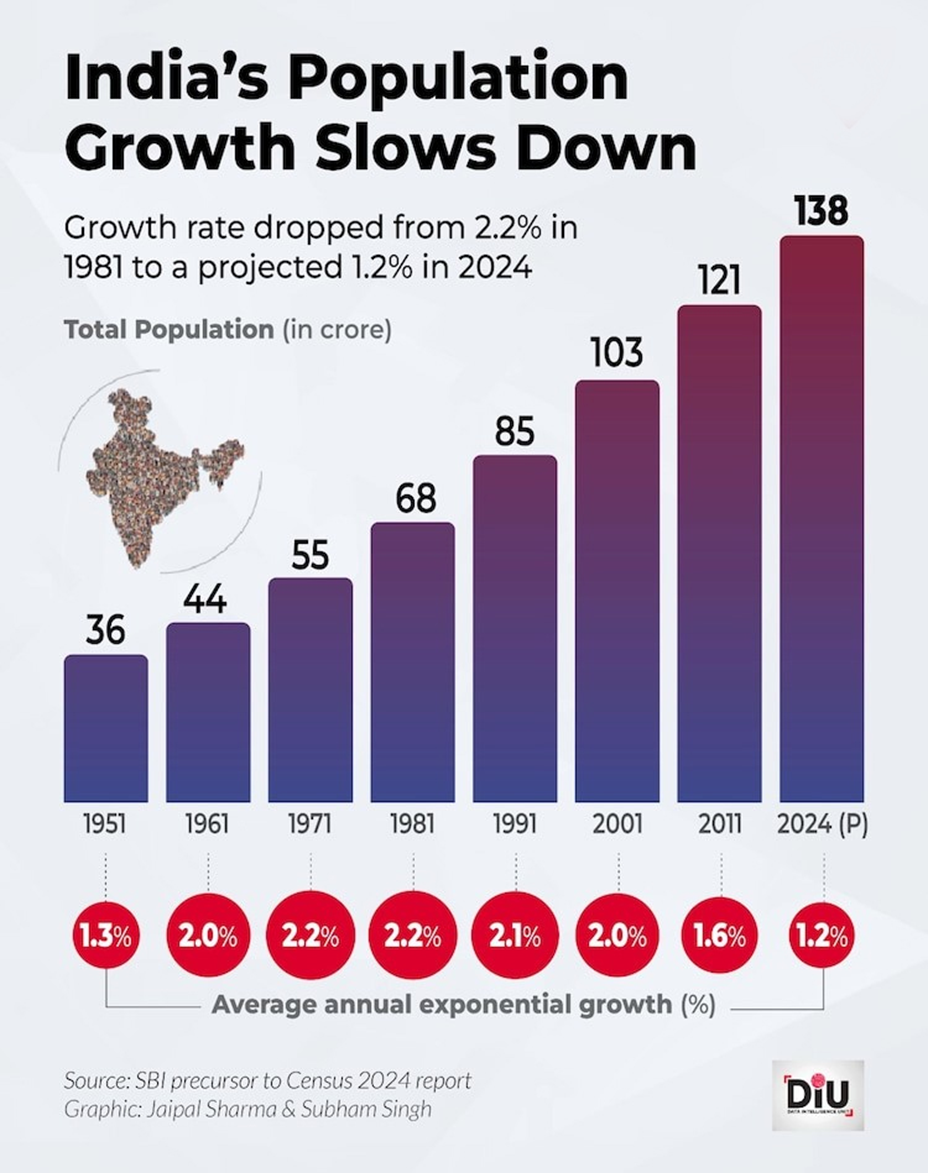India, a country of over 1.4 billion people, is undergoing a demographic transformation, characterized by a significant decline in fertility rates. This shift has sparked debates over the potential challenges of an ageing population, regional imbalances in political representation, and concerns about labour shortages. However, before making policy recommendations based on the “success” of achieving below replacement fertility rates, it is essential to critically assess the socioeconomic implications and explore the best ways to address these concerns.
Declining Fertility Rates in India
· The Total Fertility Rate (TFR) in India has now fallen to 2 children per woman, a significant decline from 6.2 children per woman in 1950. Projections suggest that by 2050, the fertility rate may drop further to 1.3 children per woman. In 2021, India saw the birth of approximately 2 crore children, a number expected to fall to 1.3 crore by 2050.
· The number of children aged 0-14 in India is also declining. In 2021, this figure stood at 36.4 crores, and by 2024, it is estimated to decrease by 2.6 crores to 34 crores. At the same time, the elderly population (above 60 years) in India has been growing steadily. In 1991, the elderly population was 6.1 crores, and by 2024, it is projected to increase to 15 crores.
The Global Fertility Decline
Falling fertility rates are not unique to India. Globally, countries like Japan are grappling with similar trends. In 2021, the global fertility rate was 2.3 children per woman, and it is expected to decline to 1.8 by 2050, with further projections suggesting a drop to 1.6 by 2100. While low-income countries may continue to see higher fertility rates, many developed countries are experiencing significant population declines.
Why Is the Fertility Rate Falling in India?
Several economic and social factors have contributed to the decline in fertility rates in India, including:
- Urbanization: Women in urban areas tend to have fewer children, influenced by career goals, education, and family planning.
- Late Marriage: Rising levels of education and career aspirations among women have contributed to delayed marriage and childbearing.
- Access to Family Planning: Increased access to contraceptives and family planning methods has empowered women to control their reproductive choices.
Effects of Falling Fertility Rates in India
Positive Effects
Some believe that a declining fertility rate will improve the standard of living. With fewer children to raise, resources can be more efficiently managed, leading to better quality of life and more investments in healthcare, education, and social infrastructure.
Negative Effects
- Economic Growth: A declining fertility rate can impact economic growth. India currently has the youngest population in the world, but a continued decline in fertility could lead to an ageing population and a shrinking workforce.
- Labour Market: The decline in the younger population may result in a reduced labour force, affecting productivity and innovation.
- Healthcare System: A growing elderly population will place significant pressure on healthcare systems and social welfare programs, requiring major investments in geriatric care and elderly support.
Regional Demographic Imbalances
The falling fertility rate is not uniform across India. States like Kerala, Tamil Nadu, and Punjab have already seen fertility rates drop below replacement levels, while states in the north and east, such as Uttar Pradesh and Bihar, still have high fertility rates. This creates regional disparities that could affect political representation and resource allocation.
For example, the process of delimitation, which allocates parliamentary seats based on population, could result in southern states losing political representation. Moreover, the Finance Commission allocates resources based on population size, and states with lower fertility rates may see a reduction in their share of central funds.
Labour Mobility and Addressing Regional Imbalances
Rather than attempting to reverse declining fertility rates, India should focus on managing regional imbalances through better labour mobility. The southern states, which have lower fertility rates, may face labour shortages, but this issue can be mitigated by improving the movement of workers from regions with higher fertility rates. This can be achieved through policies that facilitate migration, improve employment opportunities, and provide better living conditions for migrants.
Women’s Labour Force Participation
· One of the most significant opportunities arising from the demographic transition is the potential for increased female labour force participation. Despite improvements in recent years, India's female labour force participation remains low compared to other developing economies. The changing demographic structure provides an opportunity to address this issue by offering women better access to education, skill development, and career opportunities.
· With fewer children to care for, women may have more opportunities to enter the workforce, particularly in sectors that require higher levels of education and skill. The government can support this transition by creating policies that promote women’s employment and ensure equal pay, job security, and workplace equality.
The Ageing Population and Healthcare Challenges
India's elderly population is growing rapidly, presenting both challenges and opportunities. As the elderly population increases, demand for healthcare services, particularly geriatric care, will rise. The government needs to focus on creating better healthcare infrastructure for the elderly, improving social safety nets, and ensuring that the elderly are adequately supported by both family and state systems.
Despite the growth of the elderly population, India’s elderly still rely on family support more than in developed nations. However, this traditional support system must be strengthened, and alternative care solutions, such as old age homes and day-care services, should be expanded.
Policy Recommendations
Rather than focusing on increasing fertility rates, India should focus on addressing the challenges posed by an ageing population, improving labour mobility, and investing in human capital. Key policy recommendations include:
- Investing in Education and Skill Development: Focus on improving education and training to prepare the future workforce, especially women and the youth in rural areas.
- Promoting Female Labour Force Participation: Policies that promote women’s employment in the formal sector, provide job security, and address workplace discrimination.
- Improving Healthcare and Elderly Care: Increase investments in healthcare infrastructure for the elderly and introduce social welfare programs to support them.
- Regional Resource Allocation: Address regional disparities in population growth by adjusting resource allocation mechanisms to account for both fertility rates and economic needs.
Conclusion
India’s demographic transition presents a complex set of challenges and opportunities. While the decline in fertility rates is a global phenomenon, its implications for India’s economic growth, labour market, and social welfare system must be carefully managed. By focusing on human capital development, improving regional equity, and preparing for the challenges of an ageing population, India can navigate its demographic shift and continue on a path of sustainable growth. As the United Nations projects that India will remain the most populous country in the world, surpassing 1.6 billion by 2060, policymakers must adopt a holistic approach to demographic change. This should include investments in education, healthcare, labour market reforms, and social welfare systems, ensuring that India’s demographic transition benefits all its citizens.
|
Probable questions for UPSC Mains exam: Discuss the socioeconomic implications of declining fertility rates in India. How do these changes impact economic growth, labour markets, and social welfare systems? Suggest strategies to address these challenges. |








